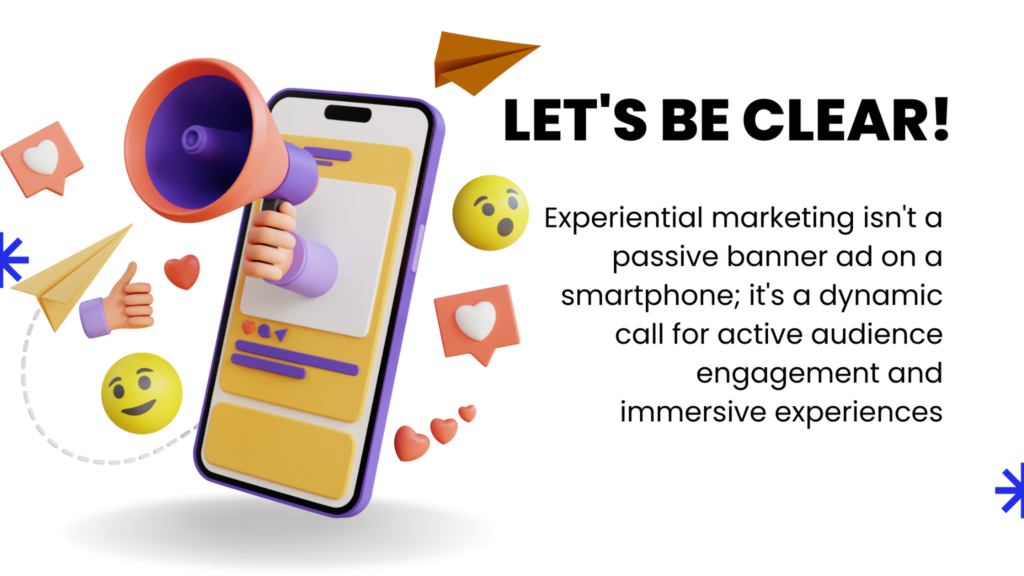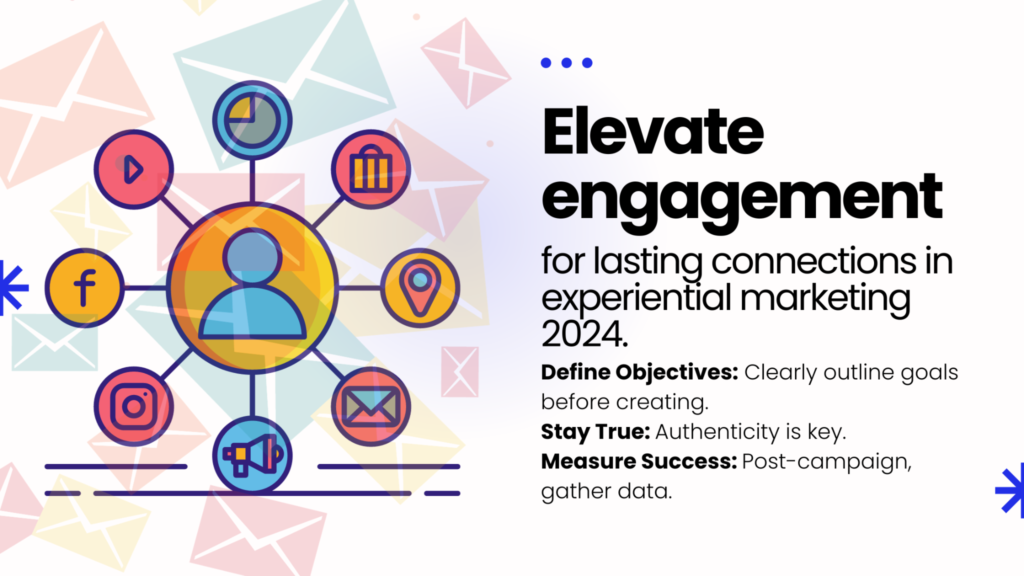Experiential Marketing in 2024: Navigating a New Era of Consumer Engagement

In the ever-evolving world of marketing, the past year has pushed employers and workers across all industries to think creatively like never before.
Marketers, who are not afraid to think outside the box and come up with creative solutions, found themselves having to adapt their strategies to stay unique in a world where Zoom meetings and virtual interactions are the norm.
One of the tactics that underwent the largest change was experiential marketing, which is now a powerful tool for engaging consumers in the new, socially disengaged setting.
What Experiential Marketing Is Not
We must clearly define what experiential marketing does not entail. It’s a call for engaged audience involvement rather than a catch-all phrase for any real marketing campaign. Experiential marketing does not include things like a static banner ad on a smartphone. True experiential marketing creates a memorable and engrossing experience by involving the target audience directly in the strategy.

Key Experiential Marketing Insights for 2023
In the latter half of 2022, an impressive 90% of B2B marketers and 70% of B2C marketers successfully organized at least one in-person event, marking a remarkable rebound in experiential marketing, as reported by Agency EA.
B2C events have witnessed a swifter recovery, with 64% of B2C brands noting that attendance has soared back to or exceeded 2019 levels (76%+), surpassing the progress seen by B2B counterparts, of which only 45% have reached similar attendance levels, according to insights from EventMarketer.
Despite the challenges, a resilient 63% of brands executed an equal or greater number of live events in 2022 compared to the pre-pandemic benchmark of 2019, signaling a robust commitment to experiential marketing, as highlighted by EventMarketer.
Looking ahead to 2023, the optimism is palpable, with 64% of B2B marketers and 40% of B2C marketers anticipating a boost in their budgets, according to findings by Agency EA.
While conferences and tradeshows experienced a more gradual resurgence, 2023 is poised to witness a significant upswing, with a projected 3.3% increase, as forecasted by the American Express Global Meetings and Events Forecast 2023.
A notable shift in perception is evident, with 68% of B2C brands and 55% of B2B brands expressing increased confidence in the value of live events compared to the pre-pandemic era, as unveiled by EventMarketer.
After experiencing a challenging contraction of 25.7% in 2020 to $62 billion, global experiential spend rebounded resiliently, growing by 8.2% in 2021 to $67.63 billion and further expanding by 11.1% to $75.16 billion in 2022. Contextually, the spend stood at $84 billion in 2019, as reported by the Global Experiential Marketing Forecast.
Projections are optimistic for a full recovery, with spending anticipated to return to pre-pandemic levels by 2024. Notably, forecasters predict that “US experiential marketing spend is projected to outpace that of overall advertising and marketing investments and US GDP by 3-6 percentage points in the 2022-2026 period.” This signals a promising trajectory for the industry, highlighting its resilience and potential for robust growth.
(Information derived from – https://atneventstaffing.com/experiential-marketing-statistics-to-know-2023/)
Types of Experiential Marketing
Immersive Experiences
Through the use of state-of-the-art virtual reality technology, immersive experiences transport users into the world of a company or item. This strategy gives traditional marketing a new angle by allowing consumers to investigate and understand a product’s advantages virtually.
Stunts
Experiential marketing stunts use relatable and shareable content to reach a broad audience. The secret is to produce content that invites readers to explore the story on a deeper level. Clever stunts create excitement and interaction, which increases brand recognition and adherence.
Innovation and Services
Developing experiential marketing campaigns that tackle practical issues can prove to be an effective tactic. It doesn’t increase sales right away, but it does establish brand credibility and casually interact with customers. This long-term strategy serves to quietly advance a brand without coming across as blatantly commercial.
Brand Activation
When launching a new product or service, brand activation seamlessly integrates with experiential marketing. Leveraging showcases is effective for introducing new offerings. Transforming product sampling into a mini-event enables customers to witness the product’s benefits, showcasing the brand in the best light.
Guerrilla Marketing
Guerrilla marketing creates buzz about a campaign and frequently incorporates a surprise element. It takes careful execution to guarantee that the audience will respond favorably. Guerrilla marketing, when executed skillfully, can be a potent instrument to captivate even the most unresponsive audiences.
(Source: https://streetpr.co.uk/different-types-of-experiential-marketing-strategies/)
Best Practices for Experiential Marketing in 2024
Set Your Goals: Prior to starting the creative process, decide exactly what you want your experiential marketing campaign to achieve. Link your approach to particular business objectives, such as expanding your audience, improving brand awareness, or just reminding people to be kind.

Maintain Your Authenticity: Success requires being sincere. Make sure the interaction embodies the personality and values of your brand to make sure it is genuine and connects with your audience.
Display ROI: After a campaign, gathering data is crucial to assessing its success. To gauge the success of your experiential marketing campaigns, monitor metrics such as downloads, website traffic, press mentions, and social media posts.
Strategic Planning for 2024
Get a Head start
Participate early in the planning phase to effectively distribute resources and incorporate emerging technologies. Taking the initiative sets up your brand for success in the dynamic market.
Have a results-driven mindset
Align marketing initiatives with targeted outcomes and make use of tools to capture and deliver content seamlessly, encouraging interaction and directing people through a sales funnel.
Cooperation is Essential
Set aside time all year long for cooperation. Ensuring the smooth execution of experiential marketing campaigns requires strategic planning, brainstorming sessions, and constant communication in successful partnerships.
Budgets and Inspiration
Experience marketing success depends on wise budget allocation. To help with budgeting, keep an eye on developments in the industry, such as the integration of new technologies and an increase in the cost of event sites. Developing effective campaigns under budget requires being creative and open to new concepts.
Experiential Marketing's Future
Experience marketing is essential for brands that want to stay relevant, not just a fad. In order to meet evolving consumer expectations, luxury brands in particular need to prioritize technology integration, safety, and hygiene. Experiential marketing can be enhanced through partnerships with a variety of industries, making it a vital strategy for the future.
Examples of international brands using experiential marketing to engage consumers include Lululemon: Proud & Present and Häagen-Dazs: Strawberries & Cream with Wimbledon (Source: https://blog.hubspot.com/marketing/best-experiential-marketing-campaigns).
Their creative marketing strategies combine cutting-edge technology and in-vogue elements to create an immersive experience that appeals to a broad audience.
In 2024, experiential marketing will need to be carefully planned, in line with corporate goals, and flexible to accommodate changes in the market. It’s a complex tactic that, when used well, maintains brands’ competitiveness while creating enduring relationships with consumers. Indian brands have the potential to create memorable and impactful brand experiences in 2024 by collaborating with others, planning ahead, and participating early in the process.
Challenges and Opportunities for Indian Brands
Although Indian brands are advancing in the field of experiential marketing, there are still obstacles to overcome. The Indian market’s diversity presents a big obstacle. Experiences must be customized by brands to accommodate a range of linguistic, cultural, and demographic needs.
But there’s also a benefit to this diversity. Companies that can genuinely relate to different demographic groups will see a huge increase in customer loyalty. Indian brands have a plethora of cultural stories to share, and sincere emotional connections are the foundation of experiential marketing.
In conclusion, experiential marketing is not just a trend; it’s a strategic imperative. Its evolution in 2024 hinges on careful planning, adaptability, and alignment with corporate goals. As we witness Indian brands overcoming obstacles and leveraging their rich cultural tapestry, the future of experiential marketing holds the promise of authentic, memorable, and impactful brand experiences.





